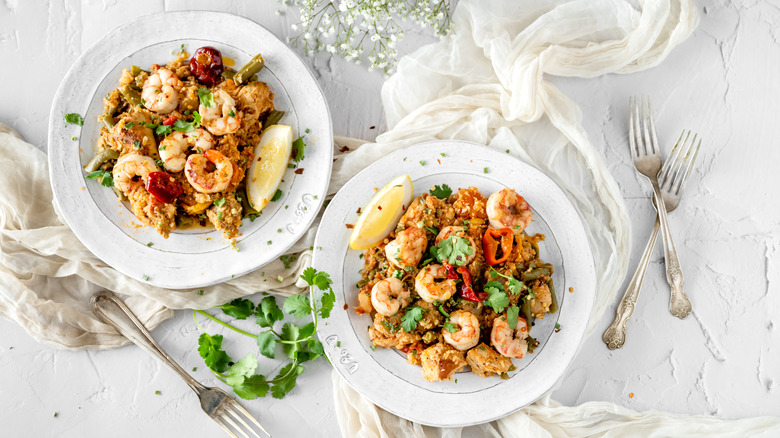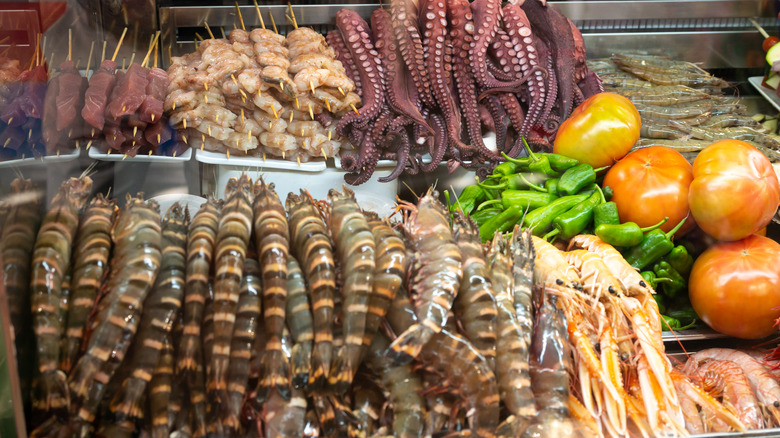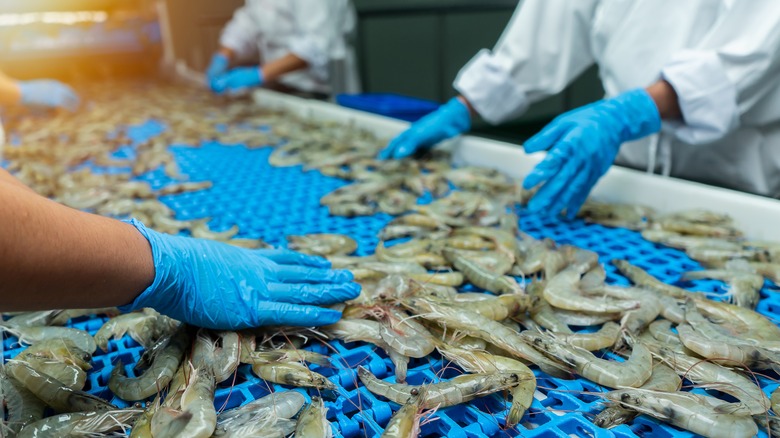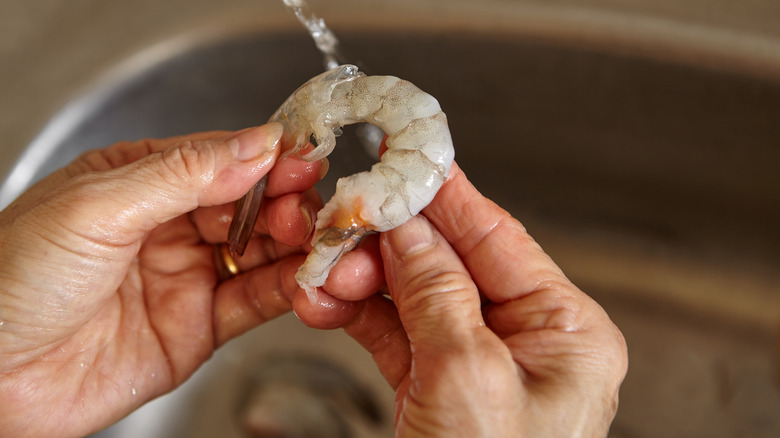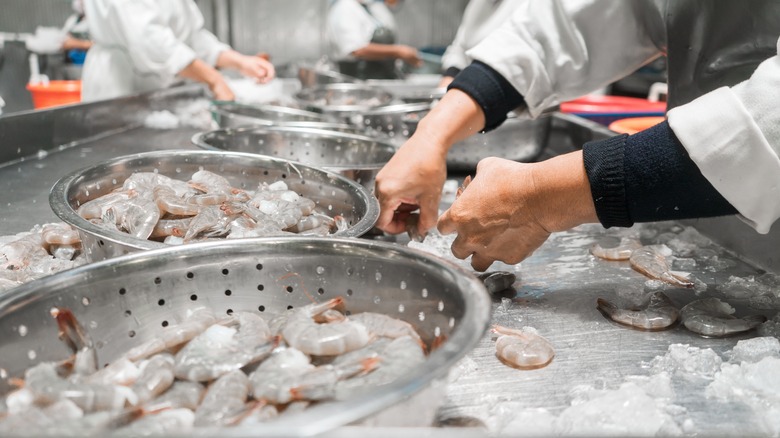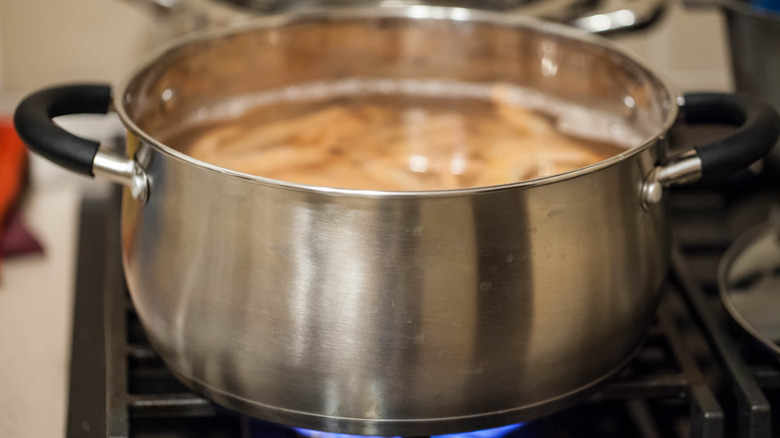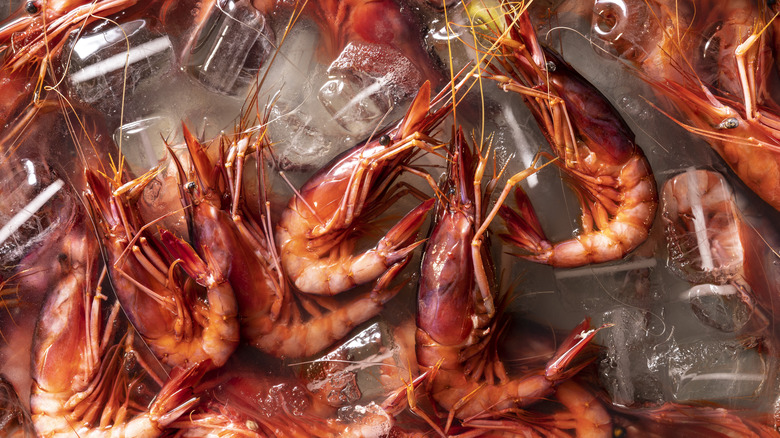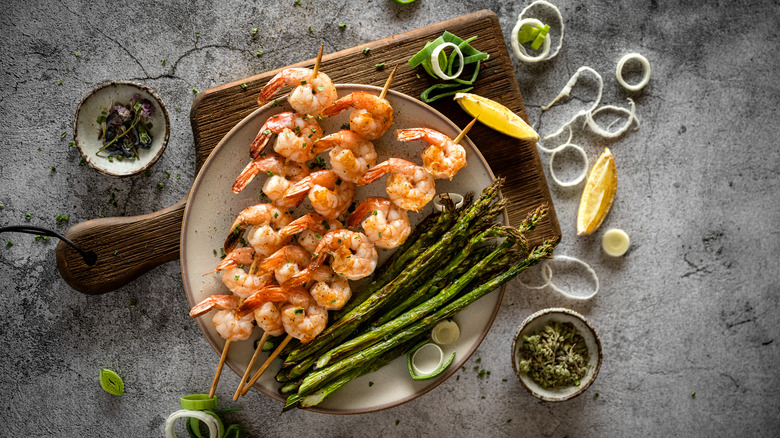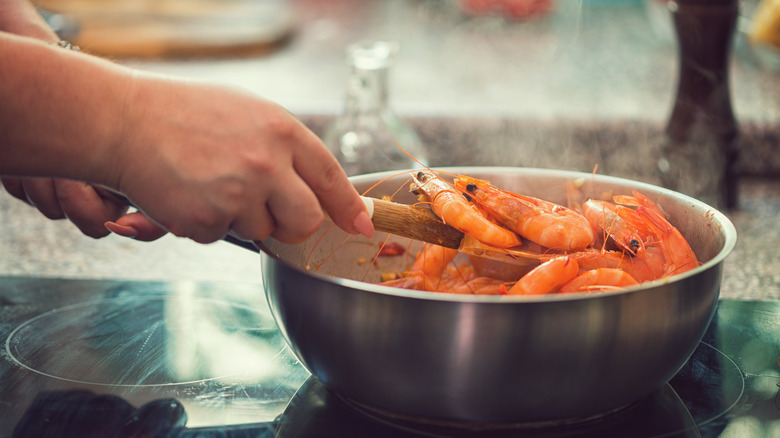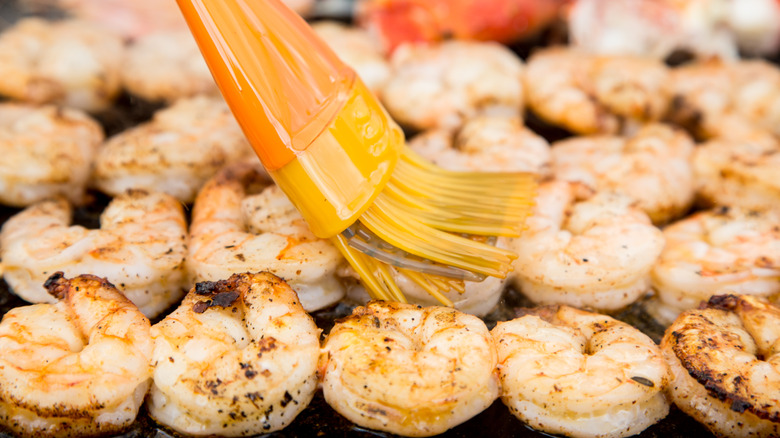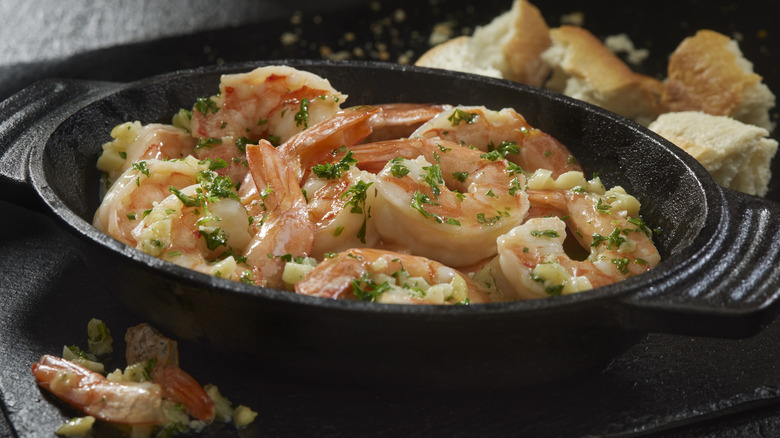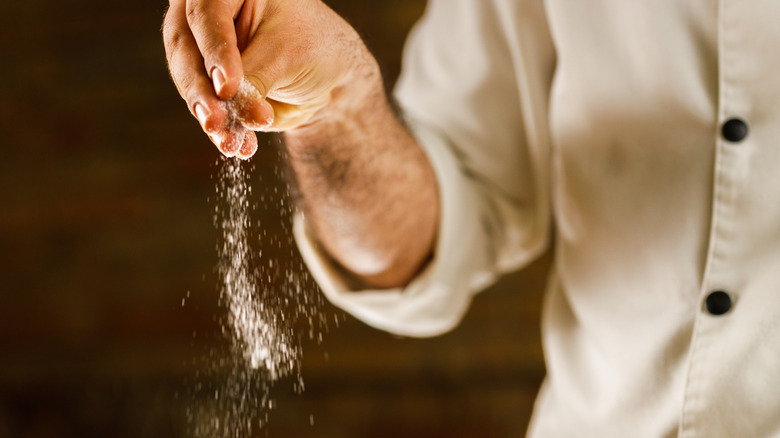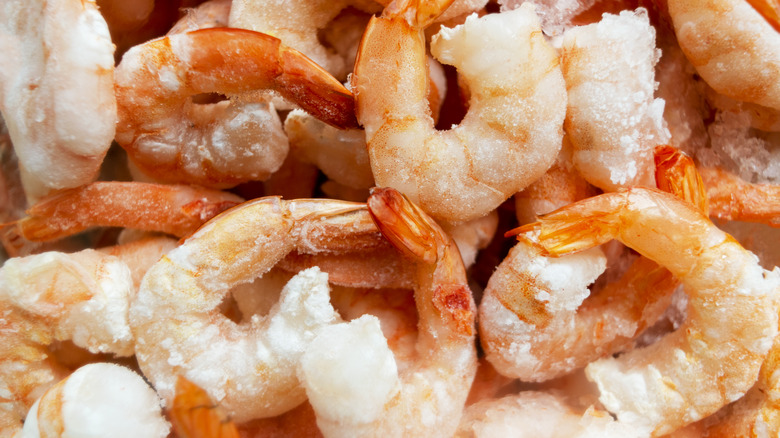Shrimp Cooking Mistakes You Should Avoid
Shrimp cocktail, shrimp alfredo, and shrimp on the barbie. These three recipes highlight at a glance many of the ways that people eat shrimp and even hint at the potential mistakes that home chefs could make when shrimp is on the menu. Everything from using the wrong size shrimp, overcooking shrimp, or not employing all the tools available to you when you cook this most popular crustacean can come into play. While the remedies to these mishaps are often easy to fix, it's exactly because they're so simple that people ignore them. And since shrimp can be pretty expensive per pound, those mishaps are costly.
Further, the mistakes that you make when cooking shrimp start long before you fire up the stove or the grill. The type of shrimp that you buy or even the way that you thaw it makes a big difference in how it turns out once it's cooked. A little preparation and know-how go a long way here. Once you learn some of the most common mistakes that people make when they're cooking shrimp, you're in a better position not to make those same miscalculations yourself and to just relax and enjoy this classic crustacean.
Not understanding how to buy fresh shrimp
Eating fresh shrimp sounds good in theory. However, finding fresh shrimp at the grocery store is sometimes harder in practice. Usually, when you see shrimp on ice at the fish counter, the shrimp isn't as fresh as you think. It looks fresh, but appearances can deceive you. Chances are good that it was chilling in the freezer just a couple of hours before.
Go for the frozen shrimp here, straight out of the fridge, instead. These shrimp were likely flash-frozen on the shrimp boat. Don't buy them from the shrimp counter because you don't know how long they've been there. However, if you buy them from the freezer, it doesn't matter. They're as close to fresh as you're going to get living in an inland city.
If you really feel like you must have an I-just-was-swimming-in-the-ocean-yesterday kind of shrimp, find a store or market that sells them live out of a tank. This may require you to take up residence in a coastal city known for its shrimp.
Regardless of whether you get shrimp from the local grocery counter or a fish market in a coastal city, smell matters. If the shrimp smells like ammonia, then it's starting to go bad and you should just leave it alone. Also, shrimps that have bruised, almost black spots are best left where they are, too. They won't be as fresh.
Neglecting to do research on sourcing
In the sustainability game, wild-caught shrimp labeled "Best Choice" is the most sustainably sourced shrimp on the market. Unfortunately, according to Seafood Watch, no shrimp currently available on the market rates that high. The next best bet for shrimp lovers is shrimp that's stamped with the "Good Alternative" label. For shrimp lovers who'd like to buy wild-caught shrimp that's responsibly sourced, here's the difference between those two labels. The former gets harvested in a way that brings with it little to no negative effects on the marine fish populations. It also comes from well-known healthy fish stocks.
In the second case, less is known about certain elements of the catch, like the type of bycatch impacts that the shrimp comes with. (Bycatch are fish that are caught alongside shrimp in the nets, some of which could be overfished or endangered in some way.) Sometimes, it means that the fishery's management leaves something to be desired. It's unknown how that company's shrimp harvesting methods impact the ecosystem or the animals and plants in the environment.
When reading the label, shrimp caught from North Carolina and Texas, as well as wild-caught shrimp from the Pacific, offer good bets. Imported shrimp from Canada's British Columbia is the shrimp to aim for from the international markets. In terms of farmed shrimp, giant tiger prawns and whiteleg shrimp from much of Asia, as well as from Nicaragua and Mexico are best left where they are.
Thawing shrimp carelessly
Shrimp are delicate creatures. Even the largest of them are quite small, and when it comes time to clean them before cooking them, their delicate natures begin to show. If thawed the wrong way, they start cooking prematurely. For example, many people thaw shrimp in warm water. This is a mistake because it can actually start the cooking process due to how delicate the shrimp are. Bacterial growth also presents a problem when you thaw shrimp in warm or hot water. This can lead to food-borne illnesses. Salmonella and E. coli stand at the forefront of possibilities here.
Options for thawing include leaving the frozen shrimp in the refrigerator overnight or giving it a bath in cold water. In both cases, you should place the shrimp in a Ziploc bag before you start the thawing process. Without the plastic bag, the shrimp will suck in the water and eventually turn soggy and mushy. It also prevents the runoff that happens during the thawing process. If you thaw them in the refrigerator, put them in their plastic bag in a glass or plastic bowl. Allow them to sit in the fridge for 24 hours.
If you're thawing them in cold water, run cold water into a large bowl and place the plastic baggie of shrimp into the water for 45 minutes. When the shrimp turns translucent, the thawing process is done.
Cleaning it improperly
Start the cleaning process with fresh, quality shrimp. If it has begun to smell or get slimy, no amount of cooking is ever going to correct that. Avoid buying it that way. Next, if you prefer to eat your shrimp peeled and deveined, this is the time to do it. Sometimes this is a matter of aesthetics, meaning that although many people prefer to eat shrimp without the shell and the vein, you don't have to remove them if you don't want to.
A good rinse in cold water comes next, followed by the removal of the head and legs. Removing the tail, if you wish, comes after that. If you're not going to eat your shrimp right away, store it in the fridge for up to 24 hours at between 32 and 38 F.
For some people, the thought of cleaning their own shrimp, as opposed to buying ready-made shrimp, is intimidating. However, keep in mind that you'll get more benefit from learning how to clean shrimp yourself than just ending up with appetizing-looking shrimp. The number of sizes you can choose from expands as does your recipe repertoire when you understand how to clean shrimp properly. That said, if you still can't face cleaning your shrimp from start to finish, it's perfectly okay to go with frozen shrimp until you gain more confidence
Not saving the shells for stock
Drag out your favorite clam chowder recipe, and you'll notice something peculiar. It calls for chicken stock. Why not seafood stock? Probably because, if you're like a lot of people, you don't keep seafood stock around the kitchen. You can remedy this deficit of seafood stock if you eat a lot of shrimp. All you need to make a chowder-worthy (or whatever) shrimp stock recipe are some shrimp shells, which you'll save the next time you eat shrimp.
Shrimp stock usually consists of the shells of shrimp, chopped-up celery and carrots, and minced onions. Some home chefs like to sauté the shrimp shells in olive oil or butter before they add in the rest of the ingredients. All of the ingredients are boiled together eventually and strained to rid the mixture of the shells. Later, it can be stored in the freezer or the fridge.
If, for whatever reason, you don't have the time to cook the shells into a shrimp stock right away, put them in a Ziploc baggie and stash them in the freezer until you're ready to cook with them. But don't wait too long. They'll only hold up in the freezer this way for three or four months max.
Not knowing whether to cook with the head on or off
If you've never had to deal with the shrimp's head, you may not know whether to remove it or leave it on when you're cleaning it. The answer isn't so cut and dry — there are reasons to remove its head as well as reasons to keep it.
The rationale for keeping the shrimp's head on when you cook it comes down to flavor. The fat in the shrimp is in its head. By cooking the shrimp with the head on, you access the fatty flavor. For some shrimp lovers, it's quite a delicacy to bite into the shrimp's head and suck out the juices once it's cooked.
Leaving the head on does have its drawbacks, of course. The head will make the shrimp mushy during the cooking process. In light of this, some home gourmands will remove the head but cook the shrimp with the shell on. Not only does this make the shrimp crispier, but it helps the shrimp retain some of the flavor that would otherwise be lost with the removal of the head. The bottom line, then, is to decide what you want to do with the shrimp and then cleaning it with that goal in mind.
Trying to cook without a skewer
Flipping a shrimp isn't quite the same as flipping a burger. Because shrimp cook quickly, flipping them individually, whether it's on the grill or in a pan, means that some of your shrimp will be overcooked and some will be undercooked simply because you can't flip each shrimp fast enough.
Enter the skewer. Sliding several shrimp on a skewer allows you to grill them quickly and turn them just as quickly because, instead of turning them one at a time when you flip the skewer, you're flipping three or four shrimp at once.
If you do use skewers when you're cooking shrimp, only allow the shrimp to cook on each side for one or two minutes. Any marinade that you wish to brush on should be applied to the shrimp during the skewer stage. Use them to top a salad, to make shrimp Alfredo, or to dress up a charcuterie board.
Cooking shrimp for too long
Rubbery shrimp happens when you set them to flame too long. They're the kind of protein that doesn't even allow for a quick trip to the mailbox once cooking commences. Instead, you need to focus on the pan or grill in front of you for two or three minutes. That's all it's going to take to cook them. You're dancing a fine line when you cook shrimp. Too much heat and too much time makes for rubbery shrimp, and too little heat and too little time makes for raw shrimp, which could make you sick.
The color is the key here, if you're wondering how to avoid this little shrimp cooking tap dance. Once the shrimp turns pink with no dark marks on it, it's ready to go. As an aside, it's worth mentioning that because of the short cooking time required for shrimp, you'll be doing some juggling if you're cooking other things. For example, if you're making a shrimp linguine alfredo recipe, you either need to plan on cooking the shrimp and setting it aside until the other ingredients are done or cooking the shrimp last.
You haven't marinaded it
Any protein, including shrimp, comes with only so much of its own flavor. Seasonings, in the form of marinade, give shrimp and other proteins a little boost with the taste buds. But that's not all a marinade does. A marinade makes meats more tender and juicy, giving you a better overall experience when you eat it.
A marinade for shrimp doesn't have to be complicated. Even something as simple as olive oil mixed with a squeeze of lemon or lime and some spices will do the trick. And in keeping with shrimp's quick-cooking nature, you don't even need to marinate it for very long. Dropping the shrimp that you're planning on cooking at tonight's barbecue into the marinade about two or three hours before dinner ought to do it. You don't want it to marinate much longer than that because some acids, like lime juice, will start to cook the shrimp before it ever makes it to the barbecue.
Choosing the wrong shrimp for the recipe
In a world where everything is mass-produced to be the same size, the same color, and the same weight, it's a bit challenging to create a uniform system for sizing shrimp. Given that all shrimp grow to their own size, it's not going to fit the mass-production model. However, most written recipes that include shrimp do somewhat follow this idea. The uniform sizing called for in the recipe isn't so much to make the dish look pretty, although that is an element of it. Rather, it's to ensure that you have the right amount of shrimp and shrimp flavor for the dish you're making.
For the purposes here, remember that the smallest shrimp, which typically comes in batches of 50 to 70 shrimp per pound, works best in salad. Spoon-size shrimp enhance soups, pastas, and the like. You'll find between 30 and 40 shrimp per pound in this size. Jumbo shrimp are big enough to allow you to stuff them with all manner of nummy things, like cream cheese and bits of mushrooms. You'll only find a dozen or so in this package. Large shrimp are the peel-and-eat kind that you would find in a shrimp cocktail. You'll have up to 30 in this package. If all of this seems to be too much to remember, just keep in mind that most recipes will tell you the size of shrimp required and approximately the number of shrimp required for the recipe.
Going heavy on the salt
Salt in the right amounts can do wonders for your shrimp. It can also overwhelm the delicate flavoring that you come to know and love from your favorite pink crustacean. Being mindful of salt levels is the key here, as is intent.
Unless you're planning on brining your shrimp, less is more when it comes to salt. You might be better off adding herbs like mint or dill to your cooking prep. If you feel like you need to sprinkle a little salt for flavoring once the shrimp is done cooking, do it then. That way your seasoning attempts won't overpower the shrimp's overall taste.
But really, you're better bet is to immerse the shrimp in a brine of salt and baking soda. As for brining, you need a 1 teaspoon-to-¼ teaspoon ratio of salt to baking soda. You'll put this amount in each pound of shrimp you're prepping. It'll sit for up to an hour or so in the fridge, and then it's ready to cook. This combination keeps the interior of the shrimp juicy while making a memorably crunchy exterior that's tasty to the last bight.
Not keeping shrimp on hand
Shrimp is a go-to ingredient for a number of different recipes. It probably goes without saying that if you need to make some last-minute meals, you need to have ingredients that lend themselves to last-minute preparation. Keeping frozen or canned shrimp on hand allows you to do that.
To make this prep tip work, it's also a good idea to have not only the secondary ingredients that you need on hand but also a couple of recipes that you've pulled that would work with said ingredients. Aside from this, knowing the shelf life for each kind of shrimp you keep on hand is a must if you want the shrimp to remain viable long enough to eat it. For example, unopened canned shrimp is good to go for three to five years. Canned shrimp works as a topping for salad, as an ingredient in a creamy shrimp dip for a charcuterie platter, or even in shrimp pasta.
If you're partial to frozen shrimp, it stays viable in the freezer for four to six months. You need to keep more of an eye on them, however, because after a certain stage freezer burn sets in. In addition to many of the recipes that canned shrimp works for, frozen shrimp, if you thaw it, is a great addition to dishes like shrimp cocktails.
